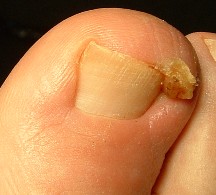 An acute paronychia is a superficial infection in the nail fold that most frequently caused by staphylococci but commonly has mixed aerobic and anaerobic flora. Chronic paronychial infections also occur, but these are usually fungal rather than bacterial in nature. Chronic and recurrent paronychial infections should be scrutinized to rule out malignancy or fungal infection. Paronychia is the most common infection of the hand representing 35% of all hand infections in the US.
An acute paronychia is a superficial infection in the nail fold that most frequently caused by staphylococci but commonly has mixed aerobic and anaerobic flora. Chronic paronychial infections also occur, but these are usually fungal rather than bacterial in nature. Chronic and recurrent paronychial infections should be scrutinized to rule out malignancy or fungal infection. Paronychia is the most common infection of the hand representing 35% of all hand infections in the US.
Minor trauma to the nail fold allows bacterial entry through the skin barrier. Patients at risk include those with skin diseases in the fingers and those with chronic dry and irritated skin such as dishwashers, florists, gardeners or housekeepers. Patients may have a history of nail biting, finger sucking, trivial finger trauma, finger exposure to chemical irritants, acrylic nails or nail glue, sculpted nails, or frequent hand immersion in water.
The redness, pain and swelling around the nail due to cellulitis are early symptoms of infection. An abscess can form if the infection does not resolve quickly. Failure to properly treat a paronychia can result in hand infection and, very occasionally, systemic infection.
The treatment of choice for a paronychia is incision and drainage under local anesthesia (digital nerve block). Other treatment measures include
- Provide warm compresses or soaks with half-strength hydrogen peroxide.
- Elevate the infected nail.
- Keep fingers clean and dry.
- Incision and drainage.





